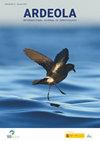黄嘴鸦(Pyrrhocorax Graculus)觅食的群集反映了高海拔生态系统中蚱蜢的可利用性和人类影响程度
IF 1.2
4区 生物学
Q2 ORNITHOLOGY
引用次数: 1
摘要
总结。山地生态系统受到许多压力,包括土地利用的变化、气温上升和娱乐活动的增加。这些因素可能会破坏食物网,威胁到生物的生存,并最终威胁到生态系统的功能。然而,对高寒生态系统中不同类群间营养联系变化趋势的研究较少。黄嘴鸟(阿尔卑斯),Pyrrhocorax graculus,一种群居鸟,成群移动,是这个框架内的理想目标物种,因为它在夏季以蚱蜢为基础的饮食,可能会出现在高度开发的娱乐活动场所。因此,我们测试了在受不同程度人为干扰的两个高寒地区,蝗群大小是否与蝗虫丰度沿海拔梯度共变化。沿海拔样带测量了蝗群大小和蝗虫丰度。分析了中位群大小与蝗虫丰度和生物量的关系,并采用负二项glm来解释时间(即6月至8月中旬)、地点和海拔的影响。在这两个研究区,在蝗虫较多的海拔高度,咳嗽群更大。这可能表明该物种有能力跟随其主要猎物昆虫的大规模波动。另一方面,蝗群大小与蝗虫生物量在自然样地呈正相关,在旅游样地呈负相关。这表明,在人类影响程度较高的地方,其他因素,如人类提供的食物的可用性,可能会扰乱咳嗽与其主要猎物之间的自然关系。总体而言,我们的结果表明,觅食黄嘴鸦的群集既反映了蚱蜢的丰度,也反映了人为影响的程度。- valino, C, Caprio, E., Genco, F., Chamberlain, D., Palestrini, C., rogero, A., Bocca, M.和Rolando, A. (2021)黄嘴鸦(Pyrrhocorax graculus)的群集反映了高海拔生态系统中蚱蜢的可利用性和人类影响的程度。《农业科学》,68:53-70。本文章由计算机程序翻译,如有差异,请以英文原文为准。
Flocking of Foraging Yellow-Billed Choughs Pyrrhocorax Graculus Reflects the Availability of Grasshoppers and the Extent of Human Influence in High Elevation Ecosystems
Summary. Mountain ecosystems are subject to many pressures, including changes in land use, rising temperatures and increasing recreational activities. These factors may disrupt food webs, threatening the survival of organisms and, ultimately, ecosystem functioning. However, few studies focus on the trends of different groups joined by trophic links in alpine ecosystems. The Yellow-billed (Alpine) Chough, Pyrrhocorax graculus, a gregarious bird that moves in flocks, is an ideal target species within this framework since it has a grasshopper-based diet during the summer and may attend sites that are heavily developed for recreational activities. We tested therefore whether flock size co-varied with grasshopper abundance along an elevational gradient in two alpine areas subject to different levels of human disturbance. Chough flock size and grasshopper abundance were measured along elevational transects. The median flock size was analysed in relation to grasshopper abundance and biomass, we also conducted negative binomial GLMs to account for effects of period (i.e. from June to mid-August), site and elevation. In both study areas, chough flocks were larger at the elevation where grasshoppers were more abundant. This may indicate the capacity of the species to follow large-scale fluctuations in their key insect prey. On the other hand, the relationship between flock size and grasshopper biomass was positive at a natural site and negative at a tourist site. This suggests that where there is a high level of human influence, other factors, such as the availability of human-provided food, may disturb the natural relationship between choughs and their key prey. Overall, our results indicate that flocking by foraging Yellow-billed Choughs reflects both grasshopper abundance and the degree of anthropogenic influence.—Vallino, C., Caprio, E., Genco, F., Chamberlain, D., Palestrini, C., Roggero, A., Bocca, M. & Rolando, A. (2021). Flocking of foraging Yellow-billed Choughs Pyrrhocorax graculus reflects the availability of grasshoppers and the extent of human influence in high elevation ecosystems. Ardeola, 68: 53-70.
求助全文
通过发布文献求助,成功后即可免费获取论文全文。
去求助
来源期刊
CiteScore
2.30
自引率
6.20%
发文量
16
审稿时长
>12 weeks
期刊介绍:
Ardeola: International Journal of Ornithology is the scientific journal of SEO/BirdLife, the Spanish Ornithological Society. The journal had a regional focus when it was first published, in 1954. Since then, and particular during the past two decades, the journal has expanded its thematic and geographical scope. It is now a fully international forum for research on all aspects of ornithology. We thus welcome studies within the fields of basic biology, ecology, behaviour, conservation and biogeography, especially those arising from hypothesis-based research. Although we have a long publication history of Mediterranean and Neotropical studies, we accept papers on investigations worldwide.
Each volume of Ardeola has two parts, published annually in January and July. The main body of each issue comprises full-length original articles (Papersand Review articles) and shorter notes on methodology or stimulating findings (Short Communications). The publication language is English, with summaries, figure legends and table captions also in Spanish. Ardeolaalso publishes critical Book Reviewsand PhD-Dissertation Summaries; summarising ornithological theses defended in Spain. Finally there are two Spanish-language sections, Ornithological News; summarising significant recent observations of birds in Spain, and Observations of Rare Birds in Spain, the annual reports of the Spanish Rarities Committee.

 求助内容:
求助内容: 应助结果提醒方式:
应助结果提醒方式:


